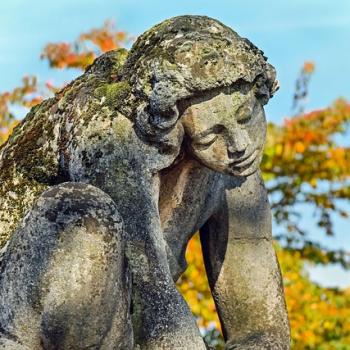Because wisdom gets personified as female throughout Scripture, and thus by Hildegard throughout her own writings, Hildegard's latter-day literary admirers have cast her as a worshipper of the Goddess Sophia (which she wasn't). Her writings on medicine and healing have gotten her labeled a holistic-health nut (which she wasn't). The fact that Hildegard occasionally let her followers dress in silk rather than the customary habits nuns wore has caused her to be cast as something of a dress-code rebel (which she wasn't), while her practice of self-mortification (fasting and flagellation), has caused her to be honored by anorexics as their own patron saint. Charlotte Allen writes that the real Hildegard would have scoffed at the insipid victimology she inspires among contemporary writers and scholars. Instead, this nun, Allen writes, "was one tough sister."
Hildegard was born to a noble family in southwestern Germany in 1098, soon after Pope Urban II commenced the first crusade. The tenth child in her family, Hildegard was dedicated by her parents to the church as a tithe—a regular practice among medieval families. However, the fact that Hildegard was a sickly child may have also had something to do with her parents handing her off to a convent.
At the convent, an anchoress named Jutta took Hildegard under her wing. For those unfamiliar with the Anchorites, they were those members of religious orders who took being dead to the world as literally as a person still living could take it. Considering the digs of a convent too posh, Anchorites lived their lives confined to one-room cells attached to a church or a convent or monastery, with only a small window to link them to the world. There they prayed and meditated on Scripture. So austere was their existence that Anchorites participated in their own funerals, complete with last rites and being laid out in a coffin, prior to their being metaphorically buried in the self-confinement of their small crypt of a room.
Jutta's room wasn't as bare as most anchorite cells—she did have a door. And it was through this door that Hildegard and about half a dozen rich girls entered to be tutored by Jutta (perhaps to the chagrin of some of their noble families). Hildegard hung out with Jutta for thirty years in that small room, learning Latin, praying to God, and writing. And then when Jutta died, Hildegard was the unanimous choice to lead the group that had formed into a cloister around Jutta's leadership.
By this time, perhaps due to the pedigree of many of its nuns, Hildegard's cloister had become lavishly endowed to the point where the ladies were living lives rather more comfortably than the monastic rules allowed. So around 1150, Hildegard along with twenty of her nuns, left to found a Spartan new convent near Bingen. "When the fear of the Lord leads, those who are poor in spirit follow;" she wrote, "for the fear of the Lord holds fast in humble devotion to the blessedness of poverty of spirit, which does not seek boasting or elation of heart, but loves simplicity and sobriety of mind, attributing its just works not to itself, but to God in pale subjection, wearing, as it were, a tunic of subdued color and faithfully following the serene footsteps of the son of God."
Life in Hildegard's cloister was devoted to worship and prayer, much of which was done in accordance with music and lyrics she composed. Here's a link to a piece of this music, here classically performed by the group Anonymous 4. Whether Hildegard's music inspires you to worship or gives you a migraine, either way, you get a sense of its ethereal nature. Her intent was to mimic the sounds of heaven, which she claimed to have heard in her own headache-inspired visions, sounds that consoled her by reminding her that her seat was already saved with God. It was this sense of safety, her confidence in being loved by Him, that enabled her to follow him wherever and however her faith took her, even to the corrupt halls of royal and ecclesial power. "I've not got the sinew of a lion, because I've never been classically taught. I'm also nothing like an early church father, because I've never been officially a student. I'm merely a too-sensitive, frail rib with mystical lungs, who saw a living, blazing fire that couldn't be put out."
In time, Hildegard's writing and musical compositions caught the attention of another 12th-century mystic, Bernard of Clairvaux, a founder of the rigorous Cistercian order. Bernard and Hildegard became avid correspondents, and eventually, Bernard secured Pope Eugenius III's approval of Hildegard's theology. Soon she was traveling all over Germany on a speaking tour, a most unusual venture for a medieval abbess, especially since most of that tour entailed her rebuking monks, clergymen, secular officials, and rank and file laypeople for their carnal transgressions and fondness for luxury.





